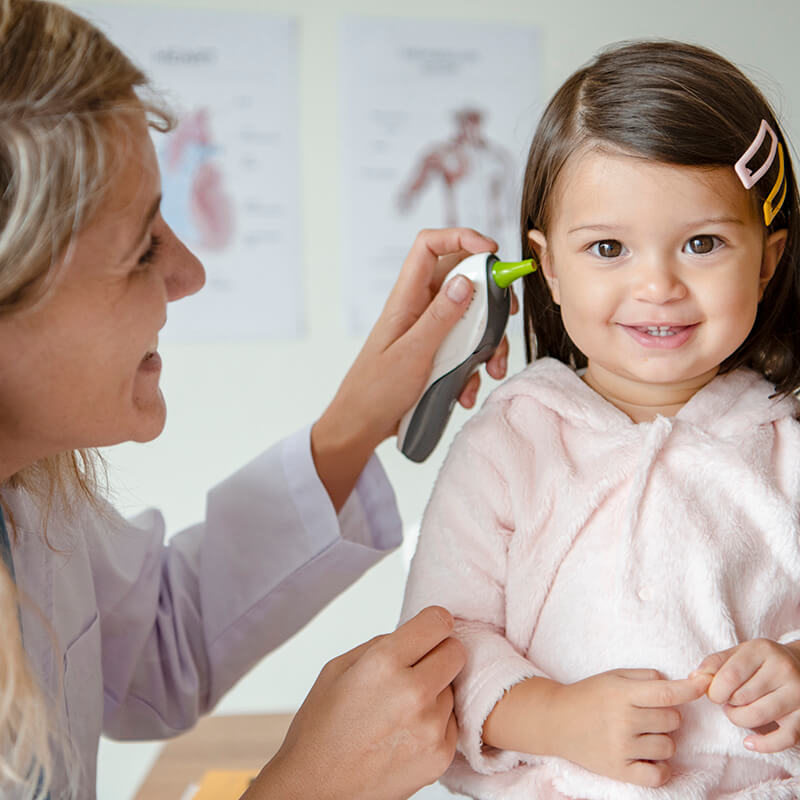New Study Shows Earlier Screening for Autism can Positively Impact Child Development
October 21, 2019
October 21, 2019

You’ve heard it from us before – evidence shows early identification of autism spectrum disorder (ASD) leads to a brighter future. We stand by the American Academy of Pediatrics’ (AAP) recommendation for universal screening at 18 months and 24 months of age, but a recent study published in the JAMA Pediatrics medical journal indicates screening at an even younger age of 14 months may be beneficial.
So, what does this mean for your family? And how can you best serve your child and keep track of developmental milestones? As a parent, it can be tough to navigate which of your child’s milestones – or lack thereof – are significant enough to record and mention to a pediatrician. Our Hopebridge team of experts breaks down the studies for you to help you put the information into action.
Walking, talking, pointing and more…the months around the first birthday are critical as it relates to development! Because this is a key growth stage, and since ASD has been detected in some toddlers as young as 12 months. This study set out to discover the stability of an autism diagnosis when a child is evaluated at 18 months or younger.
The study was completed by Karen Pierce, PhD, Valid H. Gazestani, PhD, and Elizabeth Bacon, PhD. In the study, toddlers 12-, 18- and 24- months old were systematically screened at well visits or through the general community. If a screening indicated the toddlers (age 12 months to 36 months) displayed symptoms of autism, they were referred for a formal diagnostic assessment and a follow-up evaluation at least six months later to review the diagnosis again. Researchers found if a toddler was initially identified as having autism, there is a low chance the results would appear any different when assessed again at 3 years of age. These results support the accuracy of the original autism diagnosis; serving as evidence that ASD-related answers can be reliable in the toddler years.
Nationally, the average age of identification and treatment begins around 4 years, yet this research concludes children can be reliably screened specifically for autism at an age younger than what is currently recommended. According to the data, screening at 14 months demonstrated to be more stable than any other diagnosis, both for those with ASD, as well as those identified as having typical development.

According to the data, screening at 14 months demonstrated to be more stable than any other diagnosis.
Identifying ASD as early as 14 months opens the opportunity for intensive behavioral intervention at a younger age, which is especially important when it comes to impacting social, communication and adaptive living skills.
This information is no surprise to us. Ongoing screening is important, and the sooner you can identify autism, the sooner we can intervene with strategies and supports the child and family need to live a more independent life.
Whether 18 months or 2 years old, early intensive behavioral interventions (EIBI) like applied behavior analysis (ABA therapy), are best introduced to kids with autism as soon as possible in order to increase progress and quality of life. ABA is not only effective toward the emergence of pivotal skills in communication, social situations and adaptive living situations, but when started early enough, it can also benefit children by halting or decreasing maladaptive behaviors (e.g. self-harm, aggression, hand-flapping) before they become habit.
“The neuroplasticity of the brain and receptivity of a person to acquire new skills within every domain is greatest within the first 7 years of a child’s development. This is true when it comes to building play, language, communication, social and motor skills,” said Dr. Michael J. Cameron, founder and chief scientific officer of The Cedar Group. “We need to optimize development within that critical timeframe. The sooner you can identify the signs of ASD and diagnose it, the sooner you can begin intervention; leading to a higher likelihood you’ll affect a relevant amount of learning and neuro-development.”
If you are a parent of a young child, one of the most important things you can do to aid your child’s development is become familiar with the screening tools available to you. They will help you understand the risks and signs of autism, as well as milestones for typically developing children. These are helpful for any parent – especially those in the toddler range – whether or not you suspect a developmental delay or behavioral challenges.
The Modified Checklist for Autism in Toddlers (M-CHAT) is a free screening tool written for parents to fill out and is available online. It is easy to use and you can print the results and hand it to a physician.
The M-CHAT is appropriate for kids 16 to 30 months of age, however if you notice any challenges or worrying behaviors before that time, don’t wait. Please discuss them with your pediatrician to see if there are other options for you to get a head start on screening and a diagnostic referral, if needed.

Early screening according to the AAP’s recommendations provides your child with the opportunity to lead a better life.
“Empower your family with quick and effortless screening tools that you can use to prepare for your periodic visits with the pediatrician,” said Hopebridge Director of ABA Melissa Chevalier. “Tools like the M-CHAT do not require a referral or special training; you can administer them at home. There is no commitment; it just rules in or rules out the need for a thorough assessment, in addition to providing you the information you need to advocate for your child.”
Time is precious. A waiting list to have your child evaluated is often more than three months – even up to 12 months long in some areas – and sometimes followed by another three months to receive results. To reduce long wait times, Hopebridge’s Care and Benefits Coordinators team up with our diagnosticians to work quickly, getting patients in for an evaluation in as little as 45 days, even assisting families with insurance authorizations along the way.
Like the research from Dr. Pierce, Dr. Gazestani and Dr. Bacon, there are numerous studies that show us the early years are a vital time for your child. We’ll continue to probe for the most up-to-date information and monitor the ongoing research, but whether it’s 18 months, 24 months (or even younger, as this study shows may be possible!), talk to the pediatrician about any concerns. Early screening according to the AAP’s recommendations provides your child with the opportunity to lead a better life.
Have you already screened your child for autism and still have concerns? Contact us to arrange a deeper diagnostic evaluation at a center near you.
Desire more information or background on the research outlined in this article? Here is a list of resources that may interest you:
“Evaluation of the Diagnostic Stability of the Early Autism Spectrum Disorder Phenotype in the General Population Starting at 12 months,” in JAMA Pediatrics.
CDC’s “Screening and Diagnosis of Autism Spectrum Disorder for Healthcare Providers.”
Quick facts, tools and resources within the AAP’s Autism Initiatives.
“AAP urges continued autism screening in addition to more research,” from AAP News.
Autism Therapy
September 22, 2023
Why Focusing on Self-Advocacy During Therapy is Important
Autism Therapy
December 28, 2022
Hopebridge Gives More Than 5,600 Free CEUs to its BCBAs in 2022
Autism Therapy
October 21, 2020
RBT Study Guide: The Best Resources to Become a Registered Behavior Technician
Autism Therapy
September 13, 2019
How do you Keep my Child Safe During Autism Therapy? Learn from a Hopebridge BCBA